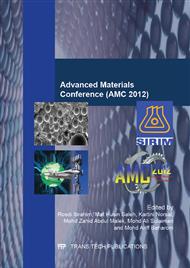[1]
J.Archbold (1999). Sintering Temperature Effects on the Mechanical Properties of Porous-Coated TI-6AL-4V ELI Alloy. (M .Applied Science Thesis, University of Toronto) p.4.
Google Scholar
[2]
Patterson MCL, Apte PS, Kimber RM, Roy R. Batch process for microwave sintering of Si3N4, Mater Res Soc Symp Proc1992. p.291–300.
Google Scholar
[3]
Groover MP. Fundamentals of Modern Manufacturing. 2nd ed. USA: John Wiley and Sons Inc; 2004.
Google Scholar
[4]
Rao KJ, Ramesh PD. Use of microwaves for the synthesis and processing of materials, Bulletin of Material Science 1995;18:447.
Google Scholar
[5]
Sunil BR, Sivaprahasam D, Subasri R. Microwave sintering of nanocrystalline WC- 12Co: Challenges and perspectives, International Journal of Refractory Metals and Hard Materials. 2010;28:180-6.
DOI: 10.1016/j.ijrmhm.2009.08.005
Google Scholar
[6]
Sutton WH. Microwave processing of ceramics, Am Ceram Soc Bull. 1989;68:376.
Google Scholar
[7]
Janney MA, Kimrey HD, Schmidt MA, Kiggans JO. Grain growth in microwave- annealed alumina, J. Am Ceram Soc. 1991;74:1675–81.
DOI: 10.1111/j.1151-2916.1991.tb07159.x
Google Scholar
[8]
Tiegs TN, Kiggans JO, Kimrey HD. Microwave sintering of silicon nitride, Ceram Eng Sci Proc. 1991;12:1981–92.
Google Scholar
[9]
Plucknett KP, Wilkinson DS. Microstructural characterization of microwave sintered silicon nitride ceramics, Mater Res Symp Proc. 1993;245:289–94.
Google Scholar
[10]
Tiegs TN, Kiggans JO, Kimrey HD. Microwave processing of silicon nitride, Mater Res Symp Proc. 1990;189:267–72.
DOI: 10.1557/proc-189-267
Google Scholar
[11]
Jones MI, Valecillos MC, Hirao K, Yamauchi Y. Grain growth in microwave sintered Si3N4 ceramics sintered from different starting powders, J Eur Ceram Soc. 2002;22:2981-8.
DOI: 10.1016/s0955-2219(02)00054-7
Google Scholar
[12]
Upadhyaya GS. Sintering 2000: A report. Journal of the Minerals, Metals and Materials Society. 2000;52:38-40.
Google Scholar
[13]
A. Mondal, A. Upadhyaya, D. Agrawal, Effect of heating mode and sintering temperature on the consolidation of 90W–7Ni–3Fe alloys, Journal of Alloys and Compounds. 509 (2011) 301-310.
DOI: 10.1016/j.jallcom.2010.09.008
Google Scholar
[14]
Surendran KP, Mohanan P, Sebastian MT. Tailoring the microwave dielectric properties of GdTiNb1-xTaxO6 and Sm1-x YxTiTaO6 ceramics , J. Eur Ceram Soc 2003;23:2489–95.
DOI: 10.1016/s0955-2219(03)00135-3
Google Scholar
[15]
S. Das, A. K. Mukhopadhyay, S. Datta and D. Basu, "Evaluation of microwave processed glass-ceramic coating on nimonic superalloy substrate", Ceram. Int. 36-3 (2010) 1125−1130 .
DOI: 10.1016/j.ceramint.2009.12.003
Google Scholar
[16]
Cheng-Hsing Hsu, Dielectric properties of B2O3-doped 0.98CeO2–0.02CaTiO3 ceramics at microwave frequency, Ceram Int 2008;34:243–7.
Google Scholar
[17]
Rabin BH, Bose A, German RM. Characteristics of liquid phase sintered tungsten heavy alloys, Int. J. Powder Metall (1989);25:21–7.
Google Scholar
[18]
R.M. German, A. Bose, S.S. Mani, Sintering time and atmosphere influences on the microstructure and mechanical properties of tungsten heavy alloys, Metall. Trans. A 23 (1992) 211–219.
DOI: 10.1007/bf02660866
Google Scholar
[19]
M.R. Ivanovic, M.Nenezic, V.Jokanovic, High temperature sintering kinetics of alpha Al2O3 powder, Science of Sintering, 35 (2003) 99-102.
DOI: 10.2298/sos0302099i
Google Scholar
[20]
A. Mondal, A.Upadhyaya,D.Agrawal, "Effect of heating mode and sintering temperature on the consolidation of 90W–7Ni–3Fe alloys,", Journal of Alloys and Compounds 509 (2011) 301–310.
DOI: 10.1016/j.jallcom.2010.09.008
Google Scholar
[21]
S.Shamsuddin, J.B Shamsul, Z. Hussain, Z. A. Ahmad. Compaction study of particulate Iron-chromium matrix composite reinforced with alumina. In Proceedings of National Metallurgical Conference 2007, UTM & IMM.
Google Scholar
[22]
W.Rahman, J.B Shamsul, M.N. Mazlee. Characterization and Optimization of Compaction Pressure in the Alumina Reinforced Iron-Chromium Composite under Microwave Sintering Process. In Proceedings of The 8th Asian-Australasian Conference on Composite Materials 2012, Kuala Lumpur.
DOI: 10.4028/www.scientific.net/kem.673.107
Google Scholar
[23]
Martin J. M. and Castro F. (2003) "Liquid Phase Sintering of P/M Aluminum Alloys: Effect of Processing Conditions", J. Mater. Process. Technol., vol. 143-144, pp.814-821.
DOI: 10.1016/s0924-0136(03)00335-2
Google Scholar
[24]
Dudas L. and Dean W. A. (1969) "The production of Precision Aluminum P/M Parts", Int. J. Powder Metall., vol.5, pp.113-124.German R. M. (1996) "Sintering Theory and Practice." John Wiley Sons, Inc., New York, NJ, USA, pp.1-312.
Google Scholar
[25]
Schaffer G. B., Hall B. J., Bonner S. J., Huo S. H. and Sercombe T. B. (2006) "The Effect of the Atmosphere and the Role of Pore Filling on the Sintering of Aluminum", Acta Mater., vol. 54, pp.131-138.
DOI: 10.1016/j.actamat.2005.08.032
Google Scholar
[26]
Hampshire S, Jack KH. The kinetics of densification and phase transformation of nitrogen ceramics. Proc Brit Ceram Soc. 1981;31:37–49.
Google Scholar
[27]
C. Padmavathi, A. Upadhyaya, D.Agrawal, "Microwave Assisted Sintering of Al-Cu- Mg- Si-Sn Alloy," Journal of Microwave Power and Electromagnetic Energy, 46 (3), 2012, pp.115-127.
DOI: 10.1080/08327823.2012.11689830
Google Scholar
[28]
W.Liu, Y.Ma , J.Zhang, Properties and microstructural evolution of W-Ni-Fe alloy via microwave sintering Int. Journal of Refractory Metals and Hard Materials 35 (2012) 138.
DOI: 10.1016/j.ijrmhm.2012.05.004
Google Scholar


